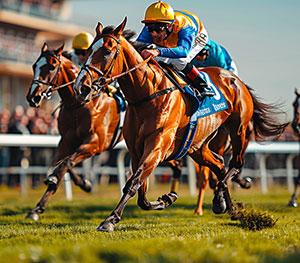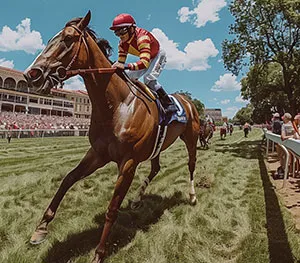Horse Racing Board Games masterfully blend the thrill of racing with strategic gameplay, offering an engaging experience for players looking for strategic betting and horse movement analysis. These games, by simulating horse races, not only provide entertainment but also sharpen decision-making skills. Whether you are a seasoned player or a newcomer, they promise unique fun and challenges.
As a seasoned horse racing board game enthusiast, I’ve had the opportunity to experience a variety of different versions, from traditional dice-based games to more modern, strategy card-driven editions. Each game has presented its own unique set of challenges and thrills, and through my journey, I’ve developed specific strategies to navigate these exciting races.
From traditional wooden boards to high-tech modern electronic versions, the range of horse racing board games is impressively extensive. Each version features its unique set of rules and gameplay, ranging from simple dice-rolling to complex card strategies, catering to players of different ages and skill levels. They are perfect for adding fun to family game nights or gatherings with friends.
In horse racing board games, strategic betting heightens the excitement and significantly boosts your chances of winning. By observing the movement of the horses and analyzing the game situation, players can make more informed decisions. Effective chip management is more than just placing bets based on intuition; it involves reading the odds, observing the behaviors of your opponents, and understanding the flow of the game. For instance, when betting on a horse with high odds, you’re betting on an upset. However, by carefully monitoring the game’s progress, you can adjust your bets, such as increasing your wager on a horse that’s showing unexpected strength or diversifying your bets when the odds shift in your favor.
Understanding Horse Dynamics in Games
Exploring the movement and strategic elements of horses in board games reveals a complex interplay of chance and strategy. Let’s delve into how these dynamics can influence game outcomes and enhance player engagement.
Horse Movement Patterns
In horse racing board games, understanding each horse’s movement patterns is key to making informed strategic bets, as each move carries potential strategic value beyond mere randomness. Understanding the specific characteristics of each horse—such as speed, stamina, and special abilities—can significantly enhance your strategic approach. For example, in some versions of the game, a horse with higher stamina may perform better in longer races, while a faster horse might excel in short bursts of speed. By aligning your betting strategy with these traits and the rules of the game, you can gain a distinct edge over your opponents. For instance, in some games, a horse’s advance may be heavily influenced by specific cards, necessitating players to predict and plan their moves thoughtfully.
Importance of Dice and Cards
Dice and cards are core elements in horse racing board games that dictate the movements of horses and play a vital role in strategic betting. Each roll of the dice or card draw involves calculating probabilities, which directly affect your strategic decisions. For instance, knowing which numbers are more likely to appear under certain conditions can help players bet and move more accurately.
Game Mechanics and Horse Advancement
Every mechanic within the game can significantly affect how horses advance. From obstacles to boost zones, different game features require players to not only plan well but also adapt to sudden changes. By thoroughly understanding these mechanics, players can better control the pace of the game and optimize their chances of winning.
Strategic Betting Techniques
Betting strategically in horse racing games involves more than luck; it requires keen observation and thoughtful decision-making. We will examine key techniques that can give players an advantage.
Observing Opponents
In horse racing board games, observation is a key to victory. Carefully watching your opponents’ betting behavior and the progress of the horses can reveal which are more likely to reach the finish line first. For instance, if a player suddenly increases their bet on a horse, it might mean they hold powerful cards that can advance that horse.
Assessing Game State
Understanding the current state of the game is crucial for making informed betting decisions. This includes assessing which horses have the potential to win and the distribution of your resources (like the number of chips). Being attuned to the progress of the game and adjusting your strategy based on how the race unfolds can greatly increase your chances of winning.
Managing Chips and Decision Making
Effectively managing your chips and decisions is at the heart of strategic betting. Setting a budget and sticking to it can prevent over-betting. Also, diversifying risks—such as not placing all your chips on one horse but balancing your bets based on each horse’s odds of winning—is crucial. Moreover, watching how the odds change and how other players are betting can provide critical information to keep you ahead in the competition. However, while strategic betting and thoughtful decision-making are key to success in horse racing board games, it’s important to remember that luck still plays a significant role. The outcomes of races can be unpredictable, and players should always bet responsibly, understanding that no strategy can guarantee a win.
Advanced Betting Strategies
While basic betting strategies focus on reading odds and observing opponents, advanced strategies involve using psychological tactics. For instance, in games with complex card systems, players might bluff or mislead opponents by feigning weakness in certain horses, creating uncertainty and forcing opponents into unfavorable bets.
Comparative Analysis of Different Game Versions
Different versions of horse racing games offer varied experiences influenced by game design and rules. This section compares these variations to highlight how they impact strategic play.
Impact of Game Variations
While the core theme of horse racing board games remains the same, variations between versions can significantly impact the gameplay experience. For example, some games focus on strategic depth, employing complex card systems to dictate horse movement, whereas others might lean more on luck, primarily progressing through dice rolls. Additionally, different games might introduce special roles or variables such as weather effects or track obstacles, adding extra layers of strategy.
Strategy Depth in Different Versions
The depth and complexity of strategy vary across different versions of horse racing board games. Complex versions are suitable for players who enjoy deliberate planning, offering more opportunities to control the outcome; simpler versions are better for family and casual play, often faster-paced and easier to pick up. For example, some complex versions may require players to manage resources like energy or money, adding uncertainty and challenge, while simpler versions might just involve deciding when to accelerate or use special cards.
Adapting to Game Changes
For versions with greater strategic depth, it’s recommended that players thoroughly understand all potential cards and rules before starting to devise effective long-term strategies. For simpler versions, players should focus on maximizing short-term decisions and opportunities, such as using event cards to turn the tides. Regardless of the version, the generally best strategy is to remain flexible, adapt to the ever-changing state of the game, and attempt to anticipate opponents’ moves.
Practical Examples and Scenarios
Take the popular ‘Racing Tycoon’ game, for example. In this game, players utilize strategy cards to advance their horses, such as ‘Sprint Cards’ for quick movement or ‘Obstacle Cards’ to hinder competitors. A successful strategy often involves acquiring these cards early in the game and using them strategically towards the race’s end. Similarly, in ‘Champion Racers,’ understanding track conditions is crucial for determining which horses to bet on based on their traits and current performance. These scenarios show how different approaches can lead to success or failure.
Real-Life Game Strategies
Let’s consider a real-life example from “Racing Tycoon,” where players use strategy cards to influence horse progression, such as “Sprint Cards” to advance their horse rapidly or “Obstacle Cards” to slow down competitors. A successful strategy involves accumulating cards early in the game and then deploying multiple sprint cards as the race nears its end, which has been proven to effectively alter outcomes in numerous games.
Learning from Betting Mistakes
In “Champion Racers,” a player decided to place a large bet on a horse that was clearly unsuitable for the current track conditions without understanding the horse’s condition and the track status. The horse performed poorly due to the slippery track, resulting in significant chip loss. This example teaches us how crucial it is to understand each horse’s characteristics and the current track conditions before betting.
Strategy Flexibility
Flexibility in strategy is key to success in gaming. For instance, in “Track Heroes,” players must continuously adjust their strategies based on real-time race information and the actions of other players. If it is observed that most players are conserving resources for later, adopting an aggressive approach by utilizing available resources to gain a quick advantage could be crucial to winning.
In this article, we have explored various strategies and versions of horse racing board games, as well as how to effectively employ these strategies to enhance gameplay and odds of success. From the analysis of different games’ rules and mechanics, it’s clear that both a deep application of strategy and a precise understanding of the game rules are key to improving player performance in the game.
Strategic gambling in horse racing board games transcends mere monetary gain; it involves mastering the art of decision-making, predicting opponents’ strategies, and thinking critically under pressure. As tabletop game designer John Doe recently mentioned in an interview, ‘Horse racing board games are unique in that they require a balance of luck and strategy. A seasoned player will often be able to outsmart their opponent by anticipating moves and adjusting their strategy accordingly.’ This insight from an industry expert highlights the strategic depth that makes these games so engaging. It teaches us how to find possibilities amidst uncertainty, how to remain composed under the pressure of gameplay, and how to learn and grow from each game session. It is these skills that make horse racing board games not just a form of entertainment, but a platform for honing minds and strategies.


